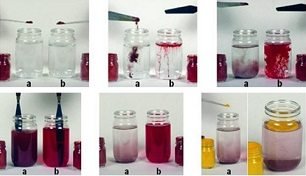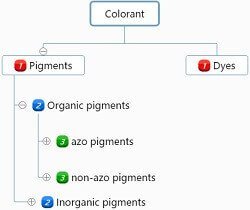Pigment Definition & Classification
What Are Pigment And Dye?
1.Pigment Definition
1.1 International Definition
Pigments are colored, black, white or fluorescent particulate organic or inorganic solids which usually are insoluble in, and essentially physically and chemically unaffected by, the vehicle or substrate in which they are incorporated. They alter appearance by selective absorption and/or by scattering of light. Pigments are usually dispersed in vehicles or substrates for application, as for instance in the manufacture or inks, paints, plastics or other polymeric materials. Pigments retain a crystal or particulate structure throughout the coloration process.-defined by CPMA (The Color Pigments Manufacturers Association, Inc.),
Dyes are intensely colored or fluorescent organic substances only, which impart color to a substrate by selective absorption of light. They are soluble and/or go through an application process which, at least temporarily, destroys any crystal structure by absorption, solution, and mechanical retention, or by ionic or covalent chemical bonds.—defined by ETAD (The Ecological and Toxicological Association of Dyes and Organic Pigment Manufacturers). Both are of categories of colorant which definition is a substance used for coloring a material, sometimes also called coloration matter or coloring matter
1.2 Simplify Definition
Pigment refers to a class of organic matter that insoluble in water, not soluble in the use of media, but has been highly dispersed state of particles so that the colored matter is colored; Dye is dissolved in water or other solvent colorants, pigment and dyes solubility in water, as follows
Picture 1 pigment and dyes solubility in water,a-pigment, b-dye
1.3 Pigment Synonyms
When we talk about pigments, there are several synonyms of pigment might be mentioned, such as color pigment, colorant, coloration, coloring agent.
Pigment Classification
2.1. Classified by Chemical Structure
Pigment can be classified into organic pigments, inorganic pigments, organic pigments which can be divided into azo pigments and non-azo pigments, as picture 2 below
Picture 2 pigment classification
Organic pigments can classify into azo pigments and non-azo pigments, which azo pigments includes monoazo yellow, orange, diazo compounds, naphthol, naphthol AS, azo lake, benzimidazolone, Bisazo condensation, metal complexes. The non-azo pigments can further subdivide into pigments such as heterocyclic and fused ring including phthalocyanine, quinacridone, perylene and perinone, thioindigo, anthraquinone, dioxazine, isoindolinone and isoindoline, diketo-Pyrrole-pyrrole (DPP), triarylcarbonium, quinophthalone.
Inorganic pigments include titanium dioxide white, carbon and plant black, iron oxide, cadmium, lead chromate, chromium oxide green, ultramarine blue, iron blue, chrome green, phthalocyanine green, mixed metal oxides, bisovanadates, Manganese oxide (MNO).
| Organic pigments | Inorganic pigments |
| Azo pigments | Titanium dioxide white |
| Monoazo yellow and orange | Carbon and vegetable black |
| Diazo | Iron oxide |
| Naphthol | Cadmium |
| Naphthol AS | Lead chromate |
| Azo lakes | Chromium oxide green |
| Benzimidazolone | Ultramarine blue |
| Diazo condensation | Iron blue |
| Metal complex | Chrome green |
| Polycyclic pigments | Phthalo chrome green |
| Phthalocyanine | Mixed metal oxide |
| Quinacridone | Bi-vanadate |
| Perylene and perinone | Manganese oxide (MNO) |
| Thioindigo | |
| Anthraquinone | |
| Dioxazine | |
| Isoindolinone and isoindoline | |
| Diketo-pyrrolo-pyrrole (DPP) | |
| Triarylcarbonium | |
| Quinophthalone |
Difference Between Organic and Inorganic Pigments
Compared with organic pigments, inorganic pigments have lower cost, simple production process and higher yield than organic pigments. also excellent light resistance, heat resistance, and weatherability. Inorganic pigment is suitable for architectural coatings, glass, ceramics, rubber, and plastics coloring.
Compared with inorganic pigments, organic pigments are widely used in the fields of ink, paint, and plastic, due to a wide range of colors, bright colors, and bright hue. a very high tinting power is formed. Organic pigments can be prepared through deep processing to meet different application requirements (such as high tinting strength, high transparency, high mobility, etc.) special commodity formulations, among them, high-performance. Organic pigments are with excellent light resistance, heat resistance, solvent resistance, and other applications performance, in line with the high-grade inks, coatings and plastics areas coloring needs. As shown in Table 1 below
Table 1 Comparison of organic and inorganic pigments
Inorganic pigments | Organic pigments | |
| Varieties of chromatography | Less variety, narrow spectrum | More varieties, wider spectrum |
| Color characteristics | lower brightness, dark | Bright, bright |
| Tinting strength | low color strength | High color strength |
| Special dosage forms | less | A variety of commercial formulations |
| Heat resistance | Most are higher | Generally low, high-performance varieties have excellent heat resistance |
| Durability (light and weather resistance) | Most varieties are higher | High-performance varieties excellent durability |
| Acid and alkali resistance | Some species discoloration decomposition | Preferably, excellent |
| Solvent resistance | excellent | Medium to fine |
| Toxicity (heavy metals) | Some varieties of high toxicity (lead, chromium, mercury, etc.) | Non-toxic, low toxicity |
| Cost | Lower | Higher |
[/accordion-item]
[/accordion]
2.2. Classified by Chromatography
Pigment can be divided into red, yellow, blue, green, orange, violet, white, black, brown pigment, they are not all independent of each other. There is a certain internal relationship between colors, as we all known, a color is determined by three parameters, which are hue, chroma, value.
2.3. Classified by Application
Pigment can be divided into ink, paint, plastic and other pigments.
2.4. Classified by Color Index
The famous “Color Index” Color Index is a color classification method, pigment is classified into pigment yellow (PY), pigment orange (PO), pigment red (PR), pigment violet (PV), Pigment Green (PG), Pigment Brown (PBr), Pigment Black (PBk), Pigment White (PW), Metal Pigment (PM) according to Color Index.
2.5. Classified by Compound Contained
Pigment can be divided into organic pigments, inorganic pigments, which Inorganic pigments can be divided into oxide, chromate, sulfate, carbonate, silicate, borate, molybdate, phosphate, vanadate, Ferricyanides, hydroxides, sulfides, metals etc.Organic pigments can be classified into polycyclic pigments such as azo pigments, phthalocyanine pigments, anthraquinones, indigoids, quinacridones, dioxazine, polycyclic pigments based on the chemical structure of the compounds.
2.6. Pigment Nomenclature
2.6.1 C.I. Generic Name or C.I.index
C.I. Common name, is the dye index (Color Index) or Generic name (Generic Name) abbreviation for each organic pigment, for example, C.I. Pigment Red 139; C.I. Pigment Red 179; etc.
2.6.2 CAS Number
Known as CAS RN, CAS registry number, also known as CAS # is a substance (compound, polymer materials, biological sequences (Biological sequences), mixture or alloy) unique digital identification number.